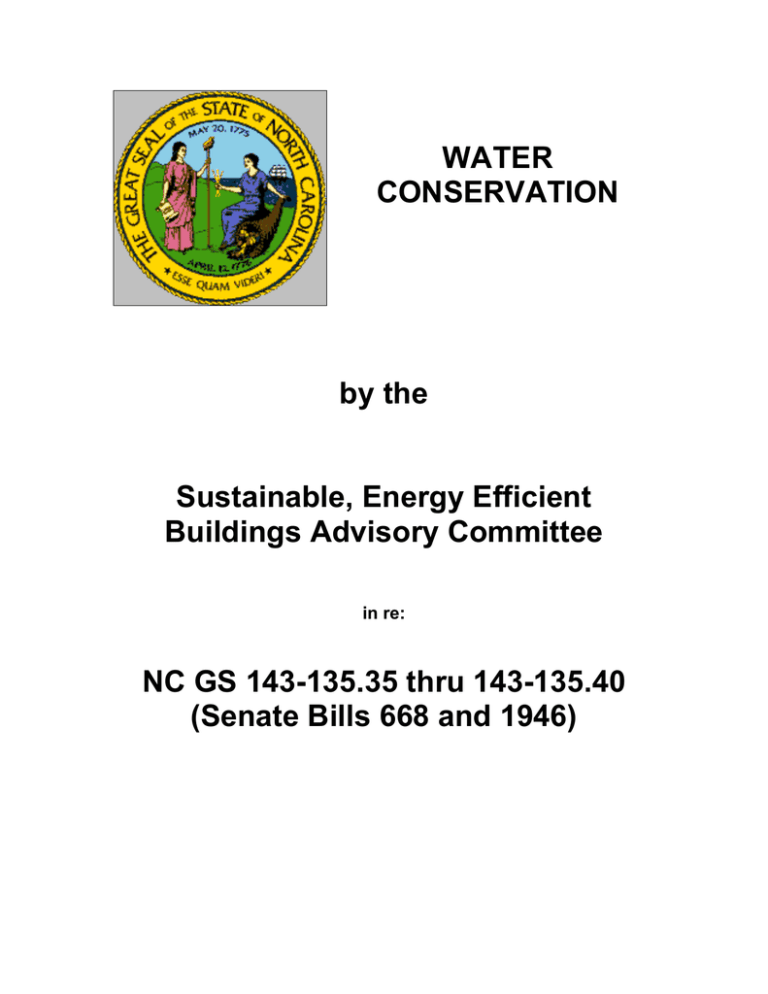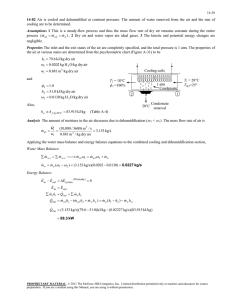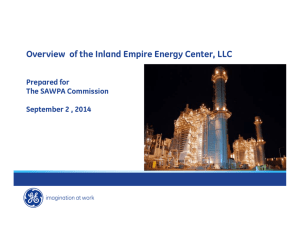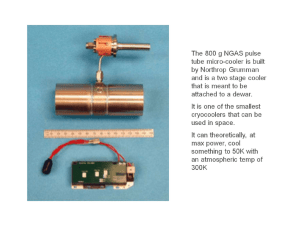Water Conservation
advertisement

WATER CONSERVATION by the Sustainable, Energy Efficient Buildings Advisory Committee in re: NC GS 143-135.35 thru 143-135.40 (Senate Bills 668 and 1946) 1-2. BUILDING WATER PERFORMANCE North Carolina General Statute 143-135.37(c) requires specific water consumption reductions as follows: 1. Indoor Water: "…the water system shall be designed and constructed so that the calculated indoor potable water use is at least twenty percent (20%) less than the indoor potable water use for the same building as calculated using the fixture performance requirements related to plumbing under the 2006 North Carolina State Building Code." 2. Outdoor Water: "…the water system shall be designed and constructed so that the calculated sum of the outdoor potable water use…is at least fifty percent (50%) less…" To comply with these requirements, the Advisory Committee recommends the following and, pursuant to these recommendations, modifications to the State Construction Manual are proposed in Appendix A. 1-2.1 INDOOR WATER CONSUMPTION Plumbing Systems Design: Table 604.4, 2006 N.C. Plumbing Code imposes the following maximum water use rates for plumbing fixtures: Water Closets: Urinals: Showerheads: Faucets: Metering faucets: 1.6 gpf 1.0 gpf 2.5 gpm at 80 psi 2.2 gpm at 60 psi (private), 0.5 gpm at 60 psi (public) 0.25 gallons per cycle, maximum However, there are numerous design options for reducing water consumption that should be evaluated for each major state facility: 1. High Efficiency Water Closets and Urinals: Gravity or tank type flush water closets, referred to as "high efficiency toilets" are now available that require 1.3 gallons per flush or less, saving about 20% in water consumption. Thus, using these fixtures in lieu of code-compliant water closets, tank type or flush valve type, should be evaluated. (As yet, though, there are no equivalent high efficiency flush valve water closets.) High efficiency urinals reduce water consumption from 1.6 gpf to 0.25-0.5 gpf. To achieve this water efficiency, these urinals typically require automatically controlled flush valves and special fixture design. 2. Dual Flush Water Closets: Flush valve water closets can be specified with dual flush mechanisms. When only liquid waste must be flushed, the flush handle is moved in one direction and the water closet consumes only about 0.8 gallon of water. When solid wastes must be flushed, the flush handle is moved in the opposite direction and 1.6 gallons of water is used. A study conducted in 2003 by California authorities indicates that the potential savings in water consumption by utilizing dual flush water closets is significant: Type of Building Office Building Restaurant Residential (Multi-Family) Ratio of Short to Long Flushes 1.7 to 1.0 1.3 to 1.0 4.0 to 1.0 Net Water Consumption (GPF) 1.10 1.15 0.96 Thus, water savings over plumbing code requirements range from 28% to 40%, depending on the type of building occupancy. 3. Composting Toilets: A composting toilet is any system that converts human waste into an organic compost and usable soil, through the natural breakdown of organic matter into its essential minerals. Aerobic microbes do this in the presence of moisture and air, by oxidizing the carbon in the organic material to carbon dioxide gas, and converting hydrogen atoms to water vapor. "Self-contained" composting toilets complete the composting "insitu", while "central unit" systems flush waste to a remote composting unit below the toilet. All composting toilets eventually need some end-product removal. A full-size composting toilet does not need to have solids removed for several decades if the active tank volume is at least three times the yearly addition. This is because the waste dramatically decreases in volume: after around 5 years only 1-2% of the original volume remains. It is then a mineralized soil, which will not decompose any further. Other smaller systems may need to remove solids several times a year. Composting toilets have entered the mainstream plumbing realm by being tested and, if approved, certified to the ANSI/NSF-41 Standard. They can be tested and certified for ANSI/NSF-41 by any ANSI accredited testing laboratories such as Canadian Standards Association, CSA International, National Sanitation Foundation, and Underwriters Laboratories. 4. Waterless Urinals: Waterless urinals save almost 95% water consumption, using water only as part of routine maintenance wash-down. These devices have been in use since the 1970s in Europe, but only arrived in the United States in mid-1990s. Waterless urinals have been found to be more hygienic than conventional ones since the aerosol effect by which bacteria can be spread is eliminated. Typically, these urinals utilize a trap insert filled with a sealant liquid instead of water. The lighter-than-water sealant floats on top of the urine collected in the Ubend, preventing odors from being released into the air. (Other designs do not use a cartridge; instead, using an outlet system that traps odors. Maintenance on waterless urinals is higher than on conventional urinals since routine cleaning and deodorizing (usually once per week) is required and the trap cartridges have to be replaced periodically (trap life depends on the number of uses, typically 7,000 - 15,000, not on the length of time it has been in use, which makes it somewhat more difficult to establish a replacement schedule). But, considering the flush valve maintenance that is eliminated, there little net increase in maintenance requirements. 5. Showers: Shower head flow can be reduced from the current limit of 2.5 gallons/minute by incorporating time-controlled valves to terminate water flow at the end of a fixed period, usually 3 to 5 minutes. Thus, water savings can easily reach 50-75% when compared to water use with a 10-15 minute shower. The best newer showerheads also allow control of water flow rate separately from flow temperature via a separate shut-off valve near the showerhead. This allows water-conscious users to reduce water flow during soaping and scrubbing and use full flow only for rinsing, all without changing the flow temperature. Users, once informed of this capability, readily adopt this water-saving practice. 6. Electronic Controls for Plumbing Fixtures: Electronic controls for plumbing fixtures usually function by transmitting a continuous beam of infrared (IR) light. With faucet controls, when a user interrupts this IR beam, a solenoid is activated, turning on the water flow. Dual-beam IR sensors or multi-spectrum sensors are generally recommended because they perform better for users with dark skin. Depending on the faucet, a 10-second hand wash typical of an electronic unit will consume as little as 1/3 quarts of water. A 10-second cycle is required as a minimum by the Americans with Disabilities Act. Choose the lowest-flow faucet valves available, typically 0.5 gpm. The additional cost for a low flow faucet with electronic sensors and controls will be $100-125. At sports facilities, where urinals experience heavy use over a relatively short period of time, the entire restroom can be set up and treated as if it were a single fixture. Traffic can be detected and the urinals flushed periodically based on traffic rather than per person. This can significantly reduce water use. Electronic controls can also be used for other purposes in restrooms. Sensoroperated hand dryers are very hygienic and save energy (compared with conventional electric hand dryers) by automatically shutting off when the user steps away. 7. Commercial Dishwashers: The design of commercial spray-type dishwashers allows for cleaning of dishes, flatware and glassware by washing with detergent and water, and sanitizing by application of hot water or chemical solutions. There are several types of commercial dishwashers for different volumes of dishes and utensils. In a stationary-rack machine, dishes are loaded into a rack that fits inside the machine; complete wash and rinse cycles average from 1 to 3 minutes. In a conveyor-type machine, dishes are loaded onto a conveyor belt that travels through the machine at speeds from 5 to 8 feet per second (fps). The final dishwashing rinse is accomplished with either hot fresh water or with a chemical sanitizing agent mixed with water. Dishwashing machines that use chemical sanitizing agents for the final rinse use about the same amount of water as machines using only hot water for the final rinse. The NSF has established minimum wash and rinse requirements for dishwashers: 4.5 to 6.0 gallons per cycle of wash and rinse for stationary rack machines using water for the final rinse and about 2.5 to 3.0 gallons per cycle for similar machines using a chemical sanitizing agent. Typically, commercial dishwashing machines reuse the final rinse water to wash the next rack of dishes. But, there are a few ways to save on water use in commercial dishwashers: • Reuse final rinse water in the following wash cycle or elsewhere for low-grade uses such as pre-wash, garbage disposals, or food scrapers. (This also offers energy savings.) • Use pressure and flow regulators to maintain the desired flow during periods of high water-supply pressure. • Specify conveyor-type dishwashers with an automatic shutdown device to deactivate the water pumps when dishes are not passing through the system. • Use 1.0-1.6 gpm pre-rinse spray valves prior to wash cycles. 8. Commercial Garbage Disposals: Commercial garbage disposals grind solid wastes into small particles for disposal into the sewer system. The ground garbage passes into a mixing chamber where it blends with water for disposal. In larger systems, a scraping and pre-flushing system may precede grinding and carry the materials to the garbage disposal. Some larger systems use a conveyor instead of a scraper to transport waste to the disposal. Typical water-consumption rates for various garbage disposals and disposals combined with scrapers or conveyor equipment are as follows: EQUIPMENT Disposal TYPICAL FLOW RATE (gpm) 5 to 8 Scraper/disposal 7 Conveyor/disposal 10 First, consider eliminating garbage disposals to reduce water use and maintenance. An option is to utilize garbage strainers in lieu of garbage disposals. A strainer-type waste collector passes a recirculating stream of water over food waste held in a basket. This reduces waste volume as much as 40 percent by washing soluble materials and small particles into the sewer. The water use for strainers is about 2 gpm, much less than the 5 to 8 gpm requirement of garbage disposals. Strainers can use wastewater from the dishwasher, eliminating added water consumption. When a disposal is used, installation of flow regulators end excess flow due to high water pressure and timers with automatic shut-off limit disposal overoperation. A solenoid valve can also be used to control water flow to the disposal. The cost impact alternative designs to reduce indoor water consumption are summarized in the following table: Code Compliant Design Alternative Design Cost (3) Description Cost (3) Min. Water Saving (%) Net Cost Difference Description Conventional WC, tank type, floor mounted Conventional flush valve WC, floor mounted Conventional flush valve WC, wall hung Conventional urinal, flush valve, wall hung Conventional shower $1,530 -$300 High efficiency tank type $1805 WC $1,830 $1,813 Dual flush valve WC $2,003 28 +$190 $919 95 -$316 $495 50 +$75 $720 20 +$300 $215 80 $0 $1,235(1) Waterless urinal $420 Shower with flow timer control Conventional shower $420 Shower with separate flow and temperature control valves Conventional lavatory faucet $215 Low flow (0.5 gpm) lavatory faucet with flow controls (1) Includes cost of water supply piping to the urinal. (3) Cost data from R.S. Means Plumbing Cost Data, 2008. 20 +$25 The recovery and recycling of wasted water is also an option, as follows: 1. Air-Conditioning Condensate Recovery: Normal operation of cooling coils produces condensate water that typically drains to the sewer. But, condensate is clean water that can be captured and reused for non-potable water applications. Typical applications include cooling tower make-up, flushing fixtures, and landscape irrigation. Design considerations for condensate recovery systems include: a. Condensate recovery works by gravity flow; A drain line runs from each air handling unit to a central connection point in the penthouse, and from there a single line runs to the cooling towers. b. Collected condensate water is at temperatures between 50 and 60°F. c. To use condensate as cooling tower make-up, a 3-way valve in the line feeding make-up water to the cooling towers is required to allow the system to draw from reclaimed condensate or service water as needed for level control. Normally, the cooling towers need more make-up water than can be recovered from the condensate, in which case the system uses supplemental domestic water. d. When occasionally there is some excess condensate, it can be diverted to waste or a cistern can be used to store the excess for later use. The amount of condensate produced by cooling will range from 0.005 to 0.0167 gpm/ton, based on the amount of outdoor air and the climatic conditions that exist. Thus, a 100 ton commercial HVAC system, operating for 2000 equivalent full load hours annually, will produce about 70,000 gallons of condensate that can be captured and used in lieu of other water sources. 2. Gray Water Systems: Gray water is the wastewater discharged from lavatories, bathtubs, showers, clothes washers, and laundry sinks, excluding the discharge from kitchen sinks. (The wastewater from flushing fixtures and kitchen sinks is generally referred to as black water.) North Carolina's building codes allow the use of gray water for flushing toilets and urinals and in subsurface landscape irrigation systems for nonresidential buildings. Field research shows that it is feasible to move away from traditional plumbing designs, which use potable water in all fixtures, and substitute gray water from bathtubs, showers, lavatories, clothes washers, and laundry trays for flushing water closets and urinals. Gray water plumbing system designs reduce demand on the potable water supply. Key requirements of a gray water plumbing system typically allowed by building codes are that the gray water must be filtered and disinfected, must be dyed (blue or green) to differentiate it from potable water, and may not be stored for longer than 72 hours (see Appendix C, 2006 North Carolina Plumbing Code). The cost of a gray water system varies with its application. A system that includes a separate collection system for irrigation use will increase conventional waste systems costs by $2.00-$3.00 per gallon of storage capacity. A more extensive system that recycles the water for flushing fixtures will be somewhat more expensive due to additional filtration, pumps, etc. 3. Rainwater Harvesting: A rainfall harvesting system consists of the following basic components: 1. Catchment surface, typically the roof of the building. 2. Collection system...the gutters and downspouts that collect and transfer the rainwater to a storage tank. 3. Leaf screens, first-flush diverters, and/or roof washers that remove dust and debris from the initial catchment runoff. First-flush diverters are designed to divert or waste a portion of the initial rainfall to eliminate contaminants that were on the catchment surface when the rainfall started. 4. Storage tanks, called "cisterns". 5. Filtration, to make the water potable, if required by the application. Given the local regulatory requirements, either cartridge filtration or RO may be required. (No filtration is required if the water is not used for human consumption.) In theory, about 0.62 gallons/sf of catchment area can be collected per inch of rainfall. However, considering first flush losses, evaporation, splash, etc., a value of 0.50 gallons/sf of catchment area per inch of rainfall is typically used for system sizing. The catchment area is based on the "horizontal projection" of the building roof and is independent of roof pitch. To ensure a year-round water supply, the catchment area and storage capacity must be sized to meet the water demand through the longest expected span of continuous dry days. The capital cost of rainwater harvesting systems is highly dependent on the type of catchment, conveyance and storage tank materials used. However, the cost of harvested rainwater in North Carolina varies from $2.00 to $3.00 per gallon of water storage. The primary reference for the design of rainwater harvesting systems is The Texas Manual on Rainwater Harvesting, available as a free download at http://www.twdb.state.tx.us/publications/reports/RainwaterHarvestingManual_3rd edition.pdf. 4. Fire Sprinkler Systems: Fire sprinkler systems waste a significant amount of potable water during routine testing and maintenance as required by NFPA Standard 25. These losses increase dramatically where a fire pump is utilized as part of the system. Almost all test water can be captured for reuse by designing (1) capture cisterns at test points in the system and/or (2) piping systems from the test points to storage tanks installed as part of another water recovery system(s) and these measures should be evaluated during the project design. HVAC Systems Design: For HVAC systems, water consumption can be defined as "direct" or "indirect". Direct water consumption is generally confined to two types of systems: open cooling towers used for condenser water heat rejection and steam boilers. Indirect water consumption is defined by the electrical energy consumption by the HVAC system and the water losses resulting from the production of electricity by a fossil-fired or nuclear power plant. To minimize the use of indirect water consumption, the electrical power consumption by the HVAC system should be reduced by reducing HVAC cooling loads through energy saving strategies, installing the very efficient primary cooling equipment, and minimizing the use of air-cooled heat rejection systems for cooling. The typical air-cooled system, even meeting 2004 ASHRAE requirements, is allowed to consume 1.267 kWh/ton-hour, compared to water-cooled limits of 0.576 to 0.703 kWh/ton-hour. Thus, water-cooled systems can save over 50% of indirect water losses in the generation of electrical power for cooling (on top of the energy and greenhouse gas emissions savings). When the evaporation and drift losses associated with water-cooled systems are considered, the overall water savings for water-cooled systems over air-cooled systems is at least 30%. Water is lost by HVAC cooling systems due to evaporation and, to a lesser extent, drift. The only way to reduce these two losses in any system is to reduce cooling water flow rates. Decreased flow rates will increase the temperature rise by the water, which may not be possible in areas with high design wet-bulb temperatures. But, in the western half of the state, this certainly should be a design option. Typical cooling tower and evaporative condenser design flow rates are typically about 3.0 gpm per ton of refrigeration load, resulting in a 10°F temperature difference. However, selecting for a 12°F temperature difference reduces the water flow rate by 20% to 2.4 gpm/ton. This effectively reduces the evaporation and drift losses by 20% also. A second loss for water-based cooling systems is the water lost intentionally through "blowdown" for water treatment. The hardness and alkalinity of the condenser water, the key factors to deposition fouling and corrosion control, is defined by (1) the hardness and alkalinity of make-up water, (2) the amount of evaporation and drift loss from the cooling tower operation, and (3) the blowdown or purposeful loss of water…throwing away condenser water with high solids concentrations to allow the introduction of makeup water with low concentrations of solids. As shown by the following table, it is clear that the amount of cooling tower make-up water is reduced significantly as the number of cycles is increased from 2 to 6: Cycles 2 3 4 5 6 10 15 20 Evaporation 0.0300 0.0300 0.0300 0.0300 0.0300 0.0300 0.0300 0.0300 Water Flow Rate (gpm/ton) Blowdown 0.0300 0.0150 0.0100 0.0075 0.0060 0.0033 0.0023 0.0015 Make-up 0.0600 0.0450 0.0400 0.0375 0.0360 0.0333 0.0323 0.0315 % Make-up 100 75 67 63 60 55 54 53 However, there is only a further 5% reduction as the cycles is increased from 6 to 10, and only a further 2% reduction as cycles is increased to 20. Therefore, in cooling tower applications, cycles of concentration should be maintained between 8 and 12 to reduce blowdown and the resulting make-up water requirement. To reduce blowdown losses further, more aggressive use of deposition inhibitors may be utilized as part of the chemical treatment program (depending on local water chemistry). The cost-effectiveness of this approach must be carefully evaluated by the designer. For cooing towers of 500 tons and greater, the design engineer should the evaluate water conservation opportunity in the cooling tower as part of the life-cycle cost analysis. The designer should evaluate the cost effectiveness of providing control and monitoring equipment, with a computer program possibly integrated with the Building Automation System. The equipment to be considered should measure flow and conductivity of the makeup water and blowdown. A water treatment model should be provided, with a calculated dosage and cost of chemicals, saturation conditions of substances in the water, and the optimum cycles of concentration. Case studies have shown optimum cycles of concentration of nine, compared to the industry standard of six, and a maximum conductivity of 2400 micromhos. However in designing a system that operates closer to the stress condition with risk of damage to equipment, the potential cost of equipment damage should be considered. The cost of repairing equipment due to damage from corrosion and scale will likely be much higher than the benefit gained from water conservation. 1-2.2 OUTDOOR WATER CONSUMPTION Outdoor water use is primarily for irrigation of lawns (turfgrass) and other landscaping. Thus, the first step in design of landscaping for state facilities is to reduce the amount of outdoor water required after the plantings are established by landscaping with site appropriate, drought-tolerant plants and grasses that can thrive with only normal rainfall. The architect and/or landscape designer is charged with providing a near-greenspace environment for state facilities, utilizing plants adaptive to the local environment, which require only the amount of water they would normally receive if grown wild (after an initial period in which to they become established). Only the following types of turfgrass should be utilized for lawn plantings for state facilities: Region (2) Mountains Acceptable Turfgrasses Tall fescue, tall fescue/Kentucky bluegrass, fine fescue (as part of a mixture with tall fescue or tall fescue/Kentucky bluegrass), or zoysiagrass Piedmont Tall fescue, bermudagrass, zoysiagrass, or centipedegrass Coastal Plain Bermudagrass, zoysiagrass, centipedegrass, or St. Augustinegrass (2) These regions shall be in accordance with the designations of the Crop Science Department, North Carolina State University. Permanent landscape irrigation systems connected only to potable water supplies, which includes underground water sources (wells), should not be installed at state facilities. Permanent landscape irrigation systems installed at state facilities should utilize captured water (rainwater, runoff-fed onsite ponds, etc.) or recovered water (HVAC cooling condensate, local gray water, treated municipal nonpotable water, etc.) to provide as much of the irrigation water supply as feasible. 2-3. WATER PERFORMANCE CALCULATIONS AND REPORTING In order for compliance with the water performance goals to be demonstrated, specific methodologies and reporting is required, as follows: Since there are no criteria within the 2006 North Carolina Building Code relative to outdoor water use, to minimize water consumption by irrigation systems, the following limitations should be imposed on state facilities. These limitations are both "feasible", as required by the legislation, and guarantee that the water reduction goals intended by legislation are met: 1. Limited Irrigated Area: Often, the entire project site not covered by buildings, parking lots, walks, roads and drives, or other impervious surfaces is both landscaped and irrigated. Thus, to reduce outdoor water use, the first step must be to reduce the area that is irrigated. A 50% reduction in water use by sprinkler systems, with an 80% coverage factor, is guaranteed by limiting the net irrigated area to 40% of the area that would be sprinklered under past designs. Thus, the total irrigated area for major state facilities shall not exceed 40% of the "net lot area", which shall be computed as the total project site area, less the total area of impervious surfaces within the project site area. Permanent outdoor athletic venues are exempt from this limitation. However, irrigation systems for athletic venues must meet all other requirements of this section. It is recommended that irrigation systems utilize captured water (rainwater, runoff-fed onsite ponds, etc.) or recovered water (HVAC cooling condensate, local gray water, treated municipal non-potable water, etc.) to the maximum extent feasible. To the extent that these systems are utilized, the irrigated area limit defined above may be increased upon approval of the State Construction Office. (Thus, if 20% of the irrigation water requirement is met by non-potable systems, the irrigated area limit may be increased by 20% to 48% of the net lot area.) 2. Maximized Irrigation Systems Efficiency: a. To the maximum extent possible, underground low volume irrigation systems, such as micro-sprayers or drip tubes, shall be utilized to minimize evapotranspiration losses. b. Sprinkler systems shall be limited to turfgrass irrigation only, shall be designed to achieve at least 80% planting coverage, minimizing sprinklering impervious surfaces and the associated runoff losses, and shall be controlled on the basis of soil moisture sensors, evapotranspiration (ET) controllers, etc. Wind speed sensors shall be used to shut-off water flow when wind speeds exceed 10 mph. Timeclock controls shall not be utilized as the sole method of irrigation system control. 3. Monitoring and Verification: Individual totalizing flow meters must be provided for each irrigation water supply (potable, captured, recovered, and/or ground source). The following forms and associated calculation methods are used to demonstrate that the water performance goals of the legislation are met:




